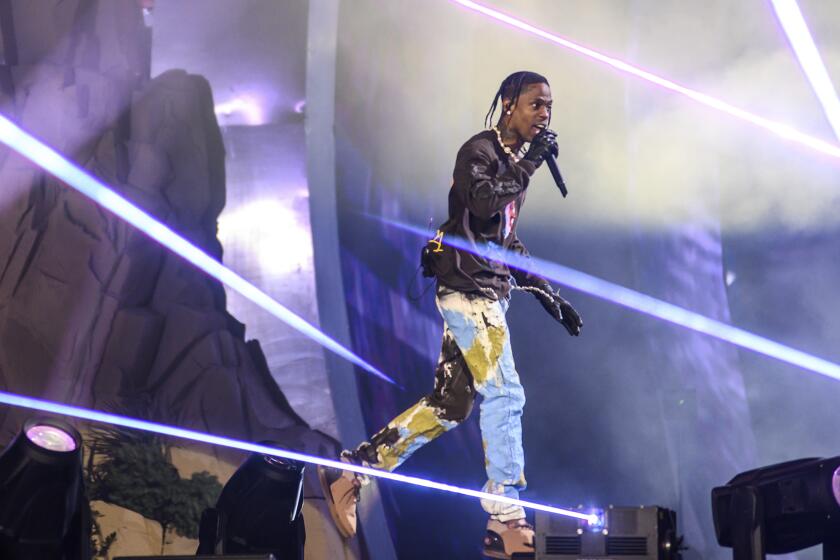Q&A: Mark Bradford on making art in post-shock phase of the Trump era and how comics channel this moment
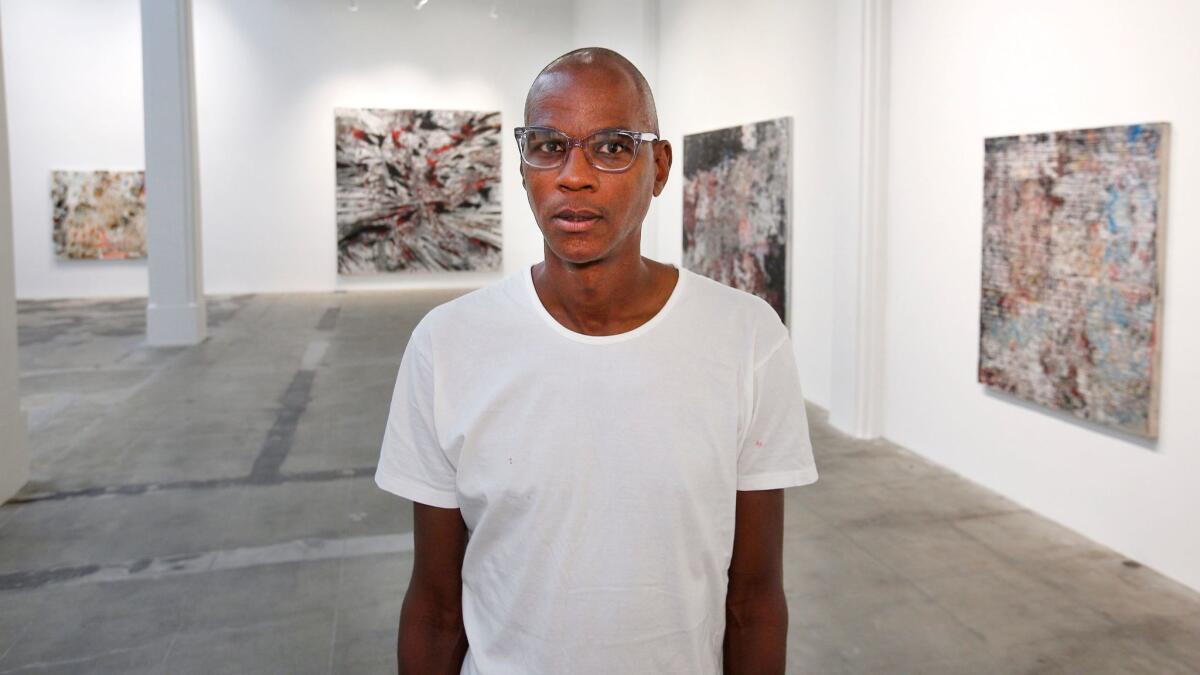
Mark Bradford folded his lanky frame into a Modernist chair in the mezzanine space at the downtown Los Angeles outpost of the global mega gallery Hauser & Wirth. After more than a year of globetrotting, he’s come home.
Last May, Bradford represented the United States at the 2017 Venice Biennale, where he transformed the neoclassical U.S. pavilion into a site of menace and decay — a mordant reflection on the violent legacies of U.S. history and the state of American democracy under the nascent Trump administration.
In November, he debuted an eight-painting work spanning nearly 400 linear feet in the circular galleries of the Hirshhorn Museum in Washington, D.C., reflecting on a decisive battle in the U.S. Civil War: Pickett’s Charge at Gettysburg in 1863.
And earlier this month, he was in London, installing a 32-panel painting in the new U.S. embassy there. For those pieces, Bradford immersed himself in the U.S. Constitution — incorporating the entire text into the work.
“It’s definitely been stadium tours,” Bradford said of his very busy year. “Now, I want to play small clubs.”
Though how small, given Bradford’s stature, is anybody’s guess. Bradford was about to open an exhibition of new paintings at Hauser & Wirth — his first solo commercial gallery show in L.A. since a 2002 exhibition at Susanne Vielmetter Los Angeles Projects — and already major collectors were taking an interest. During our interview, Interscope Records co-founder Jimmy Iovine and Guess co-founder Maurice Marciano, of the Marciano Art Foundation museum and board co-chair at the Museum of Contemporary Art Los Angeles, were cruising through the galleries for a VIP preview of Bradford’s latest work.
“Love it, love it, love it,” said Marciano, nodding at Bradford as he passed by.
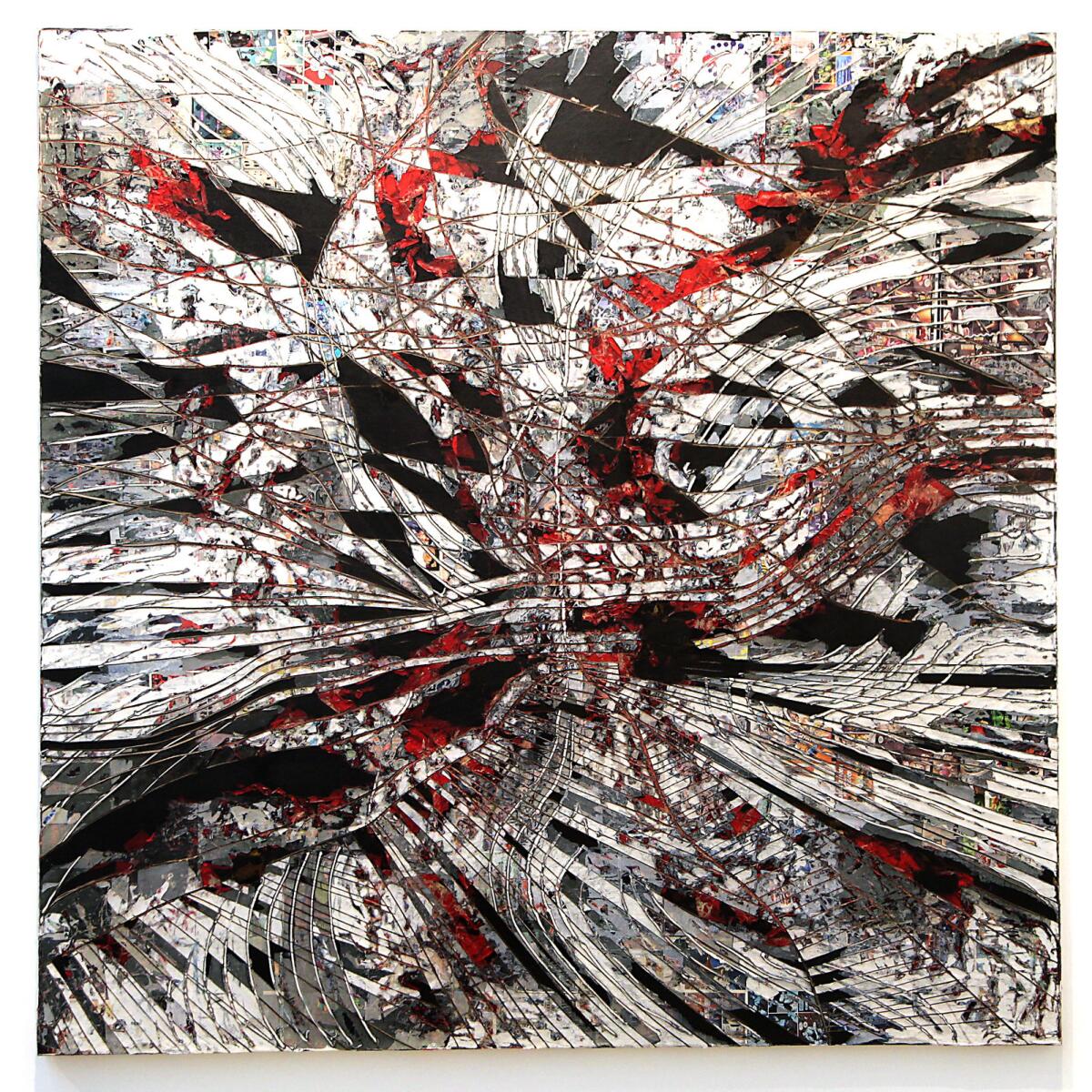
The new paintings still employ Bradford’s familiar technique of painting, collaging, scraping and cutting — for abstracted canvases that are worn rather than painted into existence. But the new series feels more explosively visceral, with a more lurid color palette. Some of that is the result of using pages from hundreds of old comic books in the layering process.
“I wanted to immerse myself in a vocabulary that was familiar to me,” Bradford said of his interest in comics.
Part of that meant frequently getting distracted by his source material.
“I’d find myself sitting there for two hours reading,” he added with a laugh. “That got to be a problem. I had to say, ‘Stop, Mark. Stop.’”
In this lightly edited chat, Bradford talks about what’s changed about making art under President Trump, the mentor he recently lost and why comics couldn’t be more relevant to the current political moment.
When you were making the installation for the Venice Biennale, you said that working in the U.S. under the Trump presidency was like making art “in a house that was burning.” Where do you think that house stands now?
Definitely, in my own emotional landscape, I’ve put out the biggest flames. This could be frightening or not frightening to say — but things are not as shocking. I think you have to believe that everything changes and everything is living. When I was putting up the piece in the embassy, I focused on the larger idea: that the Constitution will outlive one party or another.
When the Constitution was first written, women were in some ways property of the landed gentry. And certainly African American women and African American people were property. Clear property. But the people pushed back and we amended that. And even though progress is slow and we can’t see it day to day, things change.
I remember the early days of the AIDS epidemic. In the beginning, it was all epic, a romanticism, almost. There were these heaven and hell narratives. But we banded together, we did things, and people found strengths they didn’t know they had.
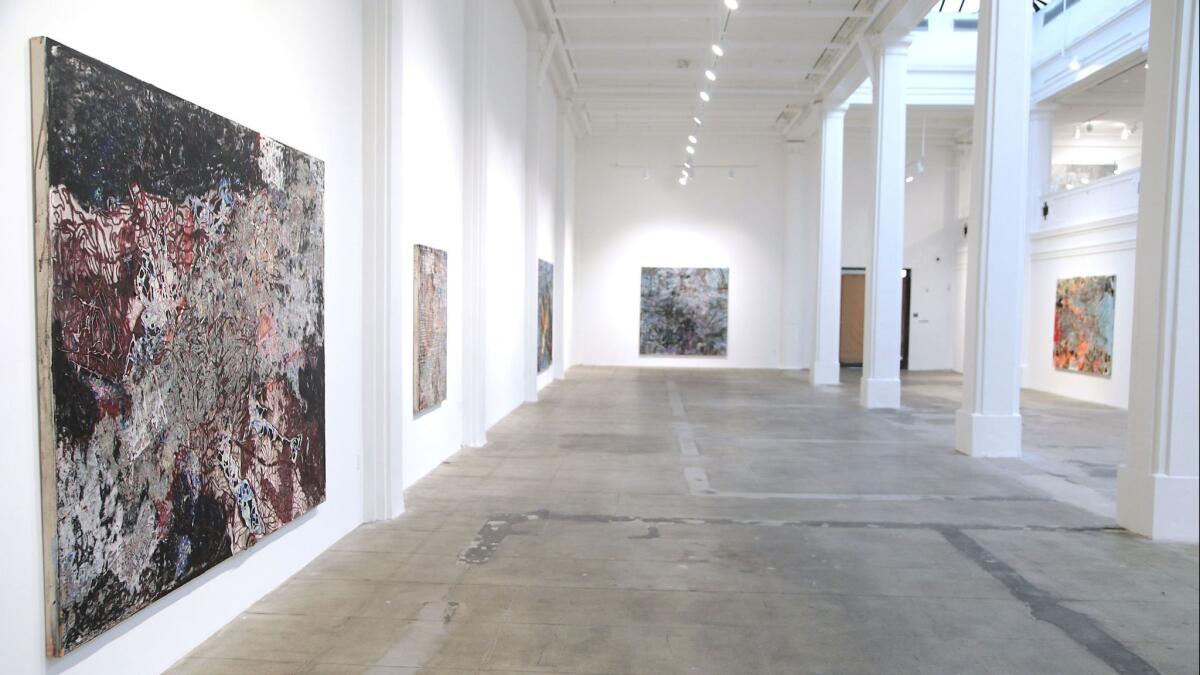
For the paintings at Hauser & Wirth, you used a lot of comic books. What about comics appeals to you at this moment?
I read comics as a kid. Marvel. Archie. Superman. Batman. Wonder Woman. The classics. All the movies you see now. Comic books are always about the meta. The archetype of this or the archetype of that. It’s civilization on steroids — and so it kind of fit with this moment. Everything is exaggerated. That’s what we’re living. That’s why “Wonder Woman” is a hit at the box office.
Plus, the colors in comic books are pow, kabow! They’re more in your face. They are these epic landscapes that you fall into, but they are also a grid. It’s just boxes. And they are these grids and grids and bubbles. If you abstract it, it’s like a Mondrian. It’s this art historical grid that goes back to Euclid — you know, back in the day.
In the new show, you have a work dedicated to abstract painter Jack Whitten, who recently passed away. How did you meet him and why was he important to you?
I met Jack’s work through the pages of very obscure art journals and through a few artist catalogs here and there. I was trying to find other African American abstract painters besides Norman Lewis. I saw Jack as this kind of incredible statesman. He was always so sure. He never doubted. Jack had a 50-year-career and he was always sure. He’d say, “Mark, it’s about the work.” He would always go to the studio and make work. He was uneven like every good artist. But what I saw was a man who was completely interested in the journey and the process of making abstract paintings.
I got to know him when he came to Hauser & Wirth. It was comforting because I could look at a lineage. There stood a man who was African American and an abstract painter. I was working on that painting [“Moody Blues for Jack Whitten”] when I got the text that he had died. I just got real blue and it was this gentler feeling. I was thinking about him while I made it. I knew Jack would say, “Now, Mr. Bradford, you finish this painting and you make it the best it can be.”
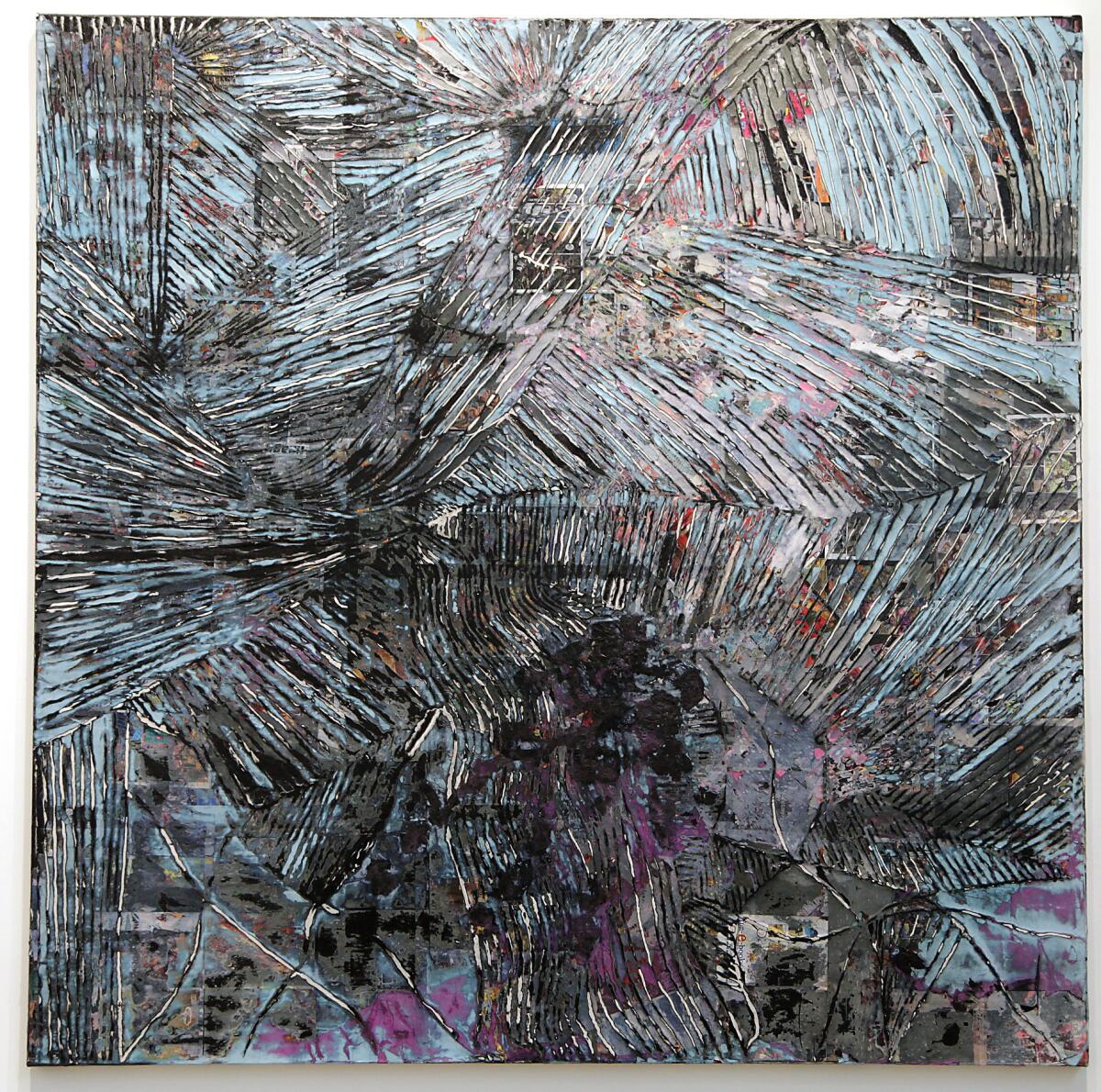
Your installation at the Hirshhorn Museum is directly inspired by French artist Paul Philippoteaux’s 1883 cyclorama “The Battle of Gettysburg,” depicting the Union victory after Pickett’s Charge, the assault named after a Confederate general. How did you arrive at the idea of the cyclorama and that story?
First, it was like, “Oh my god, how can I do anything in the Hirshhorn? What am I gonna do?” It felt like a Panopticon. Then I came across the cyclorama — big in France and big here at the turn of the last century. They were these huge propaganda machines to support these grand narratives: the burning of Paris, the Battle of Gettysburg.
So I started doing research on Gettysburg, and Pickett’s Charge was a watershed moment of the Civil War. But in the history books, there was this nostalgia for it. And at the Cyclorama in Gettysburg, this somber music comes on, like, “Oh no, he didn’t make it. Pickett didn’t make it.” And I was like, “Hallelujah!” It was really this sentiment of people that really romanticize the Old South. It was interesting and uncomfortable.
Because the cyclorama had no copyright on it, I could reproduce it. So I reproduced all eight panels and then blew it up up into billboards, into this pixelation. Then I really started working, doing my thing: layering and pulling and cutting. It took me a year.
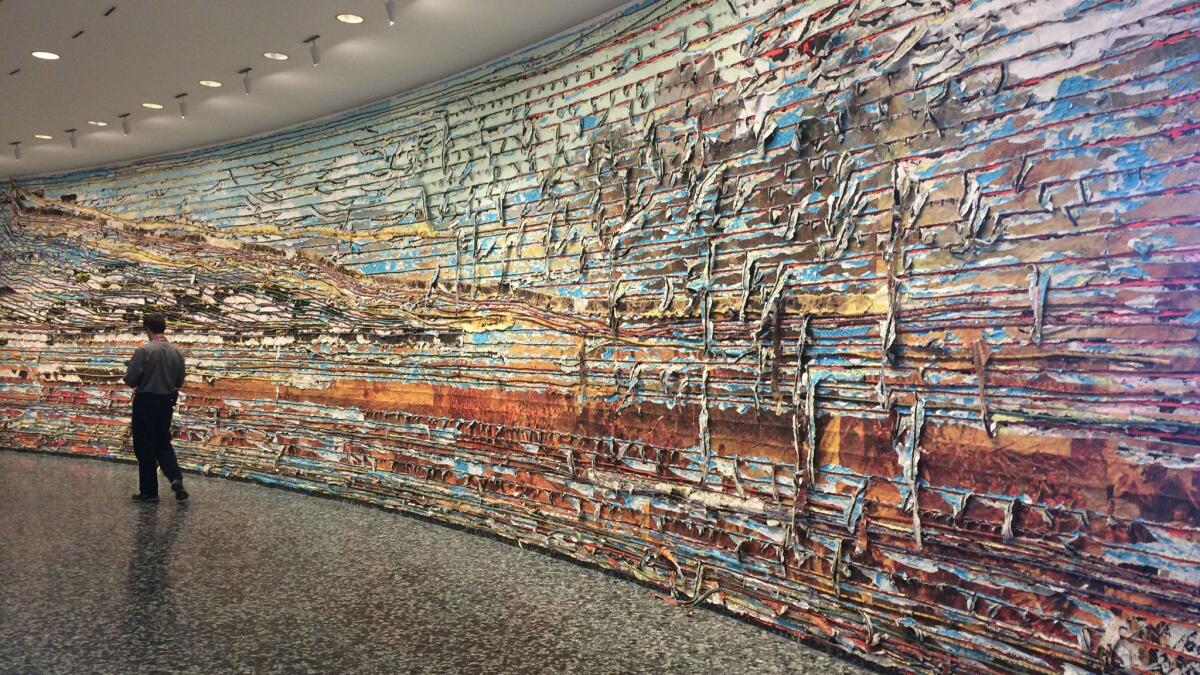
The last couple of years have brought a lot of stories in the media about links between art and gentrificaiton. You co-founded Art + Practice in Leimert Park, where there have also been such concerns. How do you manage this?
For me, transformation is different than gentrification. Since I was a long-term resident and merchant in Leimert Park, I feel very connected to the community. I haven’t left the community. Maybe I’ve moved things around, but it’s the same house for me.
We knew we didn’t want to do a gallery. That’s commerce. We wanted to focus on art, arts education and museum collaboration. Our first collaboration was with the Hammer Museum, and as a result, the community started having connections with the Hammer because they became introduced to them through us. It demystifies.
And in doing research, we found that a lot of [transitional age youth] were hanging out in the park. So we asked, how can we make the lives of foster youth better? I didn’t just want this to be art. It needed to address access and need.
But the way I see it, there are a multiplicity of visions going on. I’m just one vision.
Mark Bradford: New Works
Where: Hauser & Wirth Los Angeles, 901 East 3rd St., Los Angeles
When: Tuesdays to Sundays through May 20
Info: hauserwirth.com
Sign up for our weekly Essential Arts & Culture newsletter »
The biggest entertainment stories
Get our big stories about Hollywood, film, television, music, arts, culture and more right in your inbox as soon as they publish.
You may occasionally receive promotional content from the Los Angeles Times.



